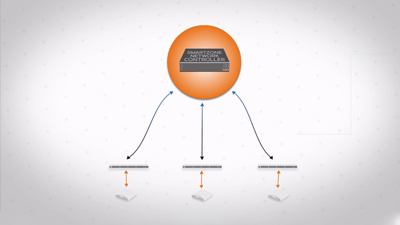Bienvenido a RUCKUS Networks, parte de la cartera líder mundial de soluciones de redes de CommScope. Más información.

El dimensionamiento automático de células de RUCKUS reduce la interferencia al cambiar dinámicamente el tamaño de las celdas de un AP
Cuando varios puntos de acceso (AP) operan en el mismo canal en un entorno de alta densidad, la cobertura puede superponerse significativamente, lo que provoca interferencias en el canal conjunto. Esto suele ser más frecuente en la banda de 2.4 GHz, donde hay un número limitado de canales disponibles y la pérdida de la trayectoria de la banda es menor que en las bandas de 5 y 6 GHz.
Para superar la interferencia de canales conjuntos de AP a AP, el dimensionamiento automático de celdas ajusta dinámicamente la transmisión de radio (Tx) de un AP y la potencia de la señal recibida (Rx) en tiempo real. Al compartir información a través de comunicaciones AP a AP, un AP puede ajustar automáticamente sus parámetros de radio al tamaño de celda ideal para las condiciones ambientales existentes, lo que mitiga la interferencia.
Producto destacado

RUCKUS SmartZone™
Los controladores de red RUCKUS SmartZone simplifican la complejidad de escalar y administrar conmutadores cableados y puntos de acceso inalámbricos a través de una única interfaz web fácil de usar. Todos los dispositivos SmartZone físicos y virtuales admiten configuración de red, supervisión, aprovisionamiento, descubrimiento, planificación, resolución de problemas, gestión del rendimiento, seguridad e informes.
Historias de clientes

Cincinnati Zoo
Conozca como RUCKUS proporcionó una variedad de puntos de acceso para interiores y exteriores, colocados de manera estratégica en todo el zoológico para una conexión Wi-Fi® excepcional.

Paycom Center
Descubra cómo Paycom Center de Oklahoma City diseñó una red cableada e inalámbrica de primera línea mediante la implementación de conmutadores y puntos de acceso de RUCKUS Networks.

Artemis Hospitals
RUCKUS Networks mejora la atención al cliente de Artemis Hospitals con soluciones de red avanzadas.

San José McEnery Convention Center
Descubra cómo el centro de convenciones San José McEnery Convention Center implementó una red de RUCKUS cableada e inalámbrica unificada para ofrecer la capacidad y el rendimiento necesarios para atraer a expositores de eventos tecnológicos de alto perfil y apoyar las expectativas de los asistentes.

WireStar Networks
Para que se utilizase una tecnología de red cableada e inalámbrica fiable y fácil de implementar en nuevas construcciones de viviendas para estudiantes de primer nivel, WireStar eligió a RUCKUS.
Recursos destacados

¿Por qué es tan difícil ofrecer Wi-Fi fiable?
El incremento explosivo en dispositivos y aplicaciones ha resultado en una demanda insaciable de Wi-Fi® más rápido y mejor durante más de una década. Las empresas han tenido dificultades para soportar el crecimiento y la arquitectura de red a medida que aumenta el número de dispositivos conectados y la cantidad de contenidos de audio en streaming.

Frost & Sullivan entrega el 2024 premio Innovación de nuevos productos en Norteamérica a RUCKUS Networks.
En un informe de 12 páginas, Frost & Sullivan elogia a RUCKUS Networks por su papel de liderazgo en el suministro de soluciones de hardware y software de redes empresariales en nueve verticales de la industria.

ABI Research reconoce a RUCKUS Networks
Por sus increíbles calificaciones en las categorías de Implementación e Innovación, ABI Research reconoce a RUCKUS como líder entre sus homólogos.

Gartner® ha reconocido a CommScope (RUCKUS) como Visionario en 2024 Magic Quadrant™ por su Infraestructura de LAN inalámbrica y cableada empresarial
CommScope (RUCKUS) ha sido reconocida por la integridad de su visión. Como Visionarios, hemos estado ayudando a proveedores de soluciones y clientes a crear redes Wi-Fi con propósitos específicos que ofrecen un alto rendimiento incluso en el entorno más difícil.
Cómo comprar
¿Busca un socio local que comprenda sus necesidades comerciales y las del sector? Encontrar un socio de canal RUCKUS.
Preguntas frecuentes
La banda de 2.4 GHz tiene menos canales, lo que crea una mayor probabilidad de interferencia de canal compartido en una red. Además, los radiadores que funcionan en la región de 2.4 GHz, como los hornos de microondas y Bluetooth®, pueden crear interferencias adicionales dentro de la banda.
La función Dimensionamiento automático de celdas está disponible en todos los AP de RUCKUS. La función se habilita a través de los controladores RUCKUS SmartZone.
Sí, el dimensionamiento automático de celdas es compatible con 2.4, 5 y 6 GHz. Si bien es más probable que se produzcan interferencias de canal compartido con 2.4 GHz, también puede ocurrir en las bandas de frecuencias más altas.

